

The Inner Planets: Mercury and Venus
Mercury orbits at an average distance of 0.387 A.U. relative to Earth but
its high eccentricity (0.205) results in a perihelion of 0.307 A.U. and aphelion
of 0.467 A.U. Its diameter is 4880 km (3030 miles) compared with 3478 km (2160
miles) for the Moon and 12756 km (7921 miles) for Earth; volumewise Mercury
is 1/50th that of Earth and three times larger than the Moon. Mercury's density
(5.44 gm/cc) is close to Earth's (5.53 gm/cc), suggesting it too has differentiated
into a crust, mantle and large iron core but presence of a weak magnetic field
implies that while the core has maybe largely solidified it has a molten component.
Without an atmosphere, Mercury is heated directly by the Sun, to which it
is the closest planet, to a mean surface temperature of 180° C (on the
perisolar side, this temperature rises to as high as 425° C; on the nightside,
it can drop to - 170° C). This innermost planet has periods of revolution
and rotation of 88 and 59 days respectively, in a ratio of 3 to 2; this relation
is said to be spin-orbit coupled.
The surface of Mercury bears no resemblance to Earth but to the casual eye is almost a twin of the Moon. This is immediately evident in this view which shows the eastern and western hemispheres of the Mercurian surface imaged by TV vidicon cameras onboard the Mariner 10 spacecraft launched on November 3, 1973 first to Venus (see below) and then past Mercury on March 29, 1974 and around the Sun twice to return for additional Mercury flybys in September 1974. and March 1975
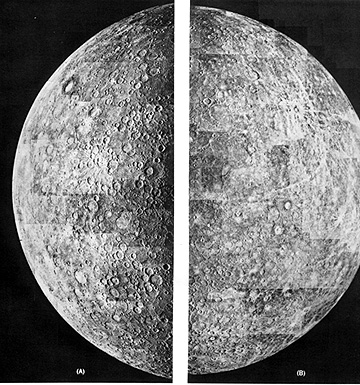
The three encounters permitted 45% of the planet to be imaged. This next view shows part of Mercury as rendered in quasi-color.
Craters, once again, are the prevalent geomorphic feature, with some impact basins exceeding 200 km (124 miles) (largest is the multi-ringed Caloris Basin at 1300 km [807 miles] diameter, part of which is seen in this next image:
19-24:
The dominance of craters is evident in this view of part of the southern hemisphere:
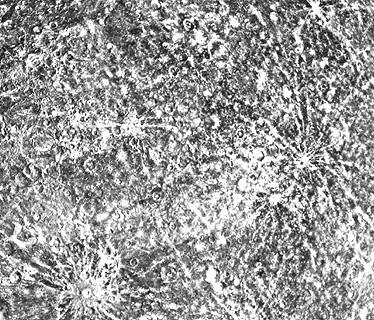
Unlike the Moon, distinctly basalt-filled maria are sparse, although some small darker patches have been seen. This implies that the general second melting that occurred on the Moon about 3.8 - 3.9 billion years ago did not happen on Mercury whose surface probably is even older and preserves the same period of impact devastation associated with the lunar highlands.
However, the bulk of the Mercurian surface is described as being a relatively flat volcanic plains made up of iron-rich lavas. Some plains units may be original crust. The most common terrain type is Intercratered Plains as seen here:
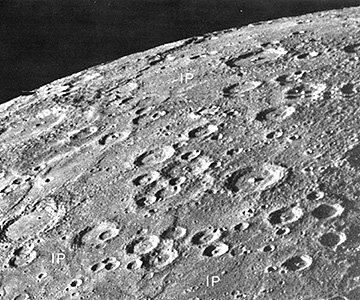
A second low relief unit has been termed Smooth Plains (although likely volcanic in origin, its mode of emplacement is debatable). It resembles visually the lunar maria and also shows a notably reduced population of craters, suggesting this Plains unit is younger than most of the mercurian surface and partly fills many older craters.
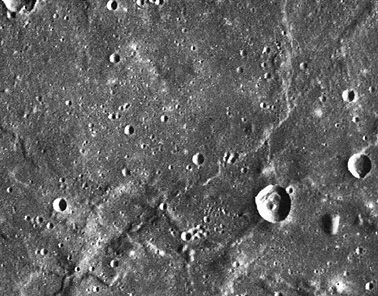
Some regions on Mercury are rugged, with large hills and lineations, as seen here. They may be a mix of ejecta units and volcanic structures.
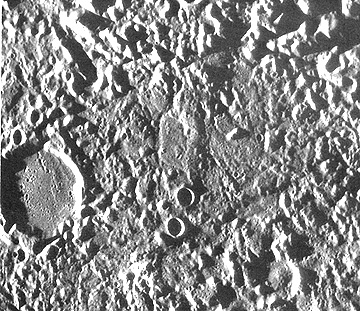
Mercury, in difference to the Moon, displays occasional structural features indicative of compression. One example is this fault, interpreted to be a thrust in nature, that forms a scarp 3 km high:
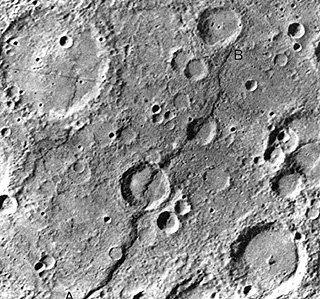
In sum, the history of Mercury is twofold: volcanic events that produced plains units and impact cratering that have greatly modified the terrains dominated by flows.
19-25:
Venus is another matter, with a complex younger surface and an intriguing history. Its high reflectivity (albedo of 0.71; it is evidenced in the night sky as the bright "Evening Star" easily seen from Earth) implies a dense shrouding atmosphere, so that knowledge of its surface would depend either on landers or on cloud-penetrating radar. Venus, which lies at 0.72 A.U. from the Sun (and comes as close as 44 million km to Earth), has a period of revolution of 225 Earth days and a retrograde rotation (spins clockwise as seen from the north pole instead of the counterclockwise motion of Earth and most other solar planets) of 243 days. Being slightly smaller than Earth (diameter: 12,100 km), and 88% of Earth's volume, Venus has sometimes been called Earth's twin, but on close examination of its atmosphere and its surface, both quite different from Earth, the similarity in size is coincidental. Venus' interior is constructed of a solid iron core (no magnetism), a thick mantle, and a thin crust whose major features are relatively young.
A series of missions by both the U.S. and the Soviet Union have unlocked some of its mysteries. Exploration of Venus by flyby probes was part of NASA's Mariner program which also included trips to Mars and the above-mentioned Mercury passes. Mariner 2, with its infrared and microwave radiometers, was the first American interplanetary probe, launched on August 27, 1962. Passing Venus as close as 41,000 km (25460 miles), it determined an approximate temperature for the outer cloud deck of ~500° C. Mariner 5, in 1967, came within 10,150 km (6300 miles), using these and a UV sensor to add more to the database. About this time, the first Soviet probe, Venera 4, descended by parachute through the atmosphere in an attempt to touch down on the surface. It apparently was crushed by the dense atmosphere (~90 atm) and high temperatures but did return information confirming that CO2 makes up about 97% of all gases present (very little water) and detecting droplets of sulphuric acid in the outer cloud deck. After two more failures, Venera 7 reached the surface and survived for 23 minutes in 1970. Venera 8 also succeeded in 1972, adding chemical composition data on radioactive U, Th, and K from analysis by a gamma ray spectrometer that suggests local rocks are potassium-rich basalts. Measured surface temperatures were ~470° C. Four more Veneras reached the surface between 1975 and 1982; each carried a photographic system that returned pictures of the immediate surroundings. Two views, taken from Venera 9 and 10, disclose a rocky surface; note in the upper image a distinctive rock that reminds some viewers of a MacDonald's hamburger.
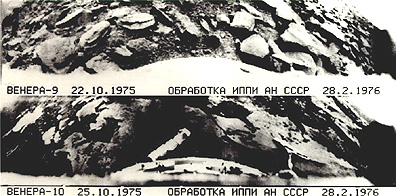
A view in color from Venera 13 suggests an iron-rich oxidized surface:
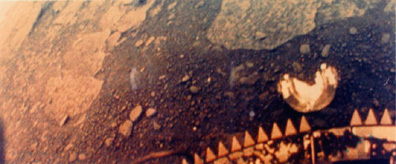
19-26:
The next U.S. probe to Venus was Mariner 10, arriving in February 1974. Using a special UV filter, its imaging camera was able to penetrate the CO2-dominated atmosphere to detect cloud swirls that emphasized concentrations of excited carbon monoxide, suitable as markers of the general circulation patterns (winds up to 370 km/hr [230 mph] within the gas envelope).
Two Pioneer Venus spacecraft arrived at the planet in December 1978 and were placed into orbit; Pioneer Venus 2 deployed a landing probe that survived for about an hour. They operated mass and ultraviolet spectrometers, an infrared radiometer, and a radar altimeter to profile-map the surface tracks over which they passed, leading to a topographic map (100 m [305 ft] vertical accuracy) covering more than 90% of the planet.
The inpenetrable cloud cover masking Venus was first penetrated by Earth-based imaging radar beams sent from antennae at the Arecibo Observatory in Puerto Rico, the Goldstone Tracking Station in California, Haystack in Massachusetts, and others. Wavelengths vary from 3.8 to 70 centimeters. Interference techniques using Doppler shifts process the reflected signals which offer some information on dielectric constants, surface roughness, slopes and rather crude estimates of elevation differences. Surface resolutions (areal) can be as low as 100 km (62 miles) or can be better than 3 km (2 miles). Here is an image showing variations in intensity of a backscattered radar beam transmitted to Venus at 12.5 cm from the Jet Propulsion Laboratory's Goldstone Tracking Station in the Mojave desert.
Even these earlier radar images pointed to a relatively flat Venus but with some highlands exceeding 6 km (3.7 miles). The Soviet Venera 15 and 16 (1983) carried imaging radar (8 cm wavelength) capable of 1-2 km (0.6-1.2 miles) ground resolution that gathered coverage over about 25% of the planet. The scene below is in the general Ishtar Terra region of northern Venus and shows the eastern part of Laksmi Planum, the wrinkled Maxwell Montes, and the large crater Cleopatra, a scene well over 2000 km (1240 miles) wide at the base.
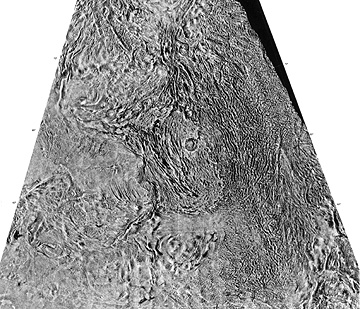
19-27:

Primary Author: Nicholas
M. Short, Sr. email: nmshort@epix.net
Contributor Information
Last Updated: September '99
Site Curator: Nannette Fekete